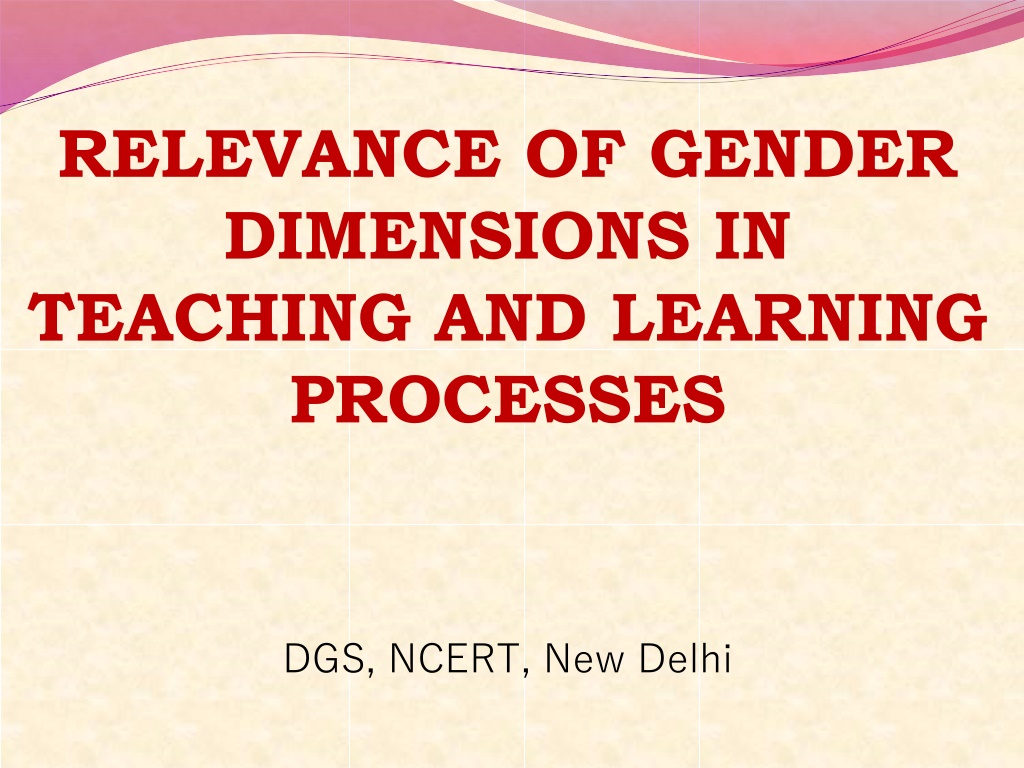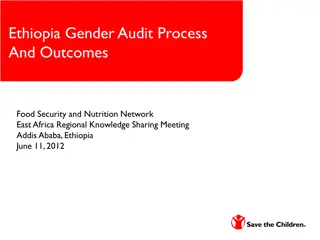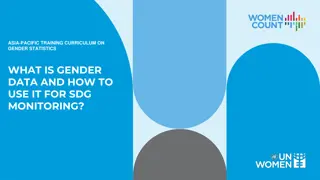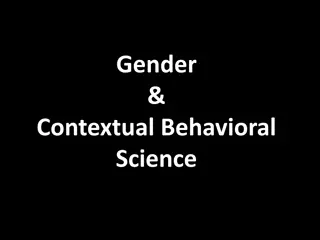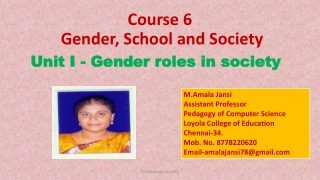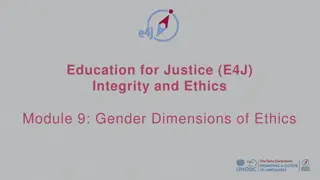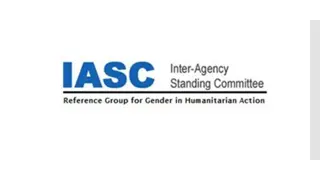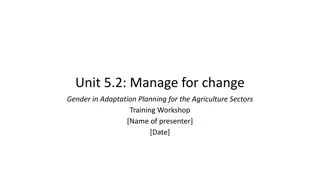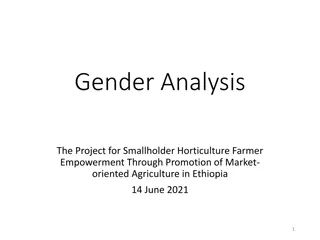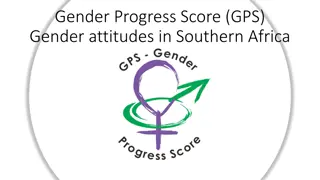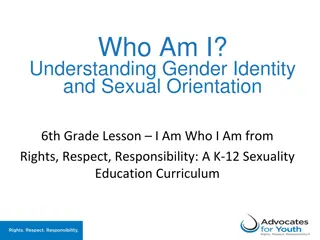Understanding Gender Dimensions in Teaching and Learning Processes
Explore the relevance of gender dimensions in teaching and learning, focusing on addressing biases and promoting gender-sensitive pedagogy. Learn to identify and overcome gender stereotypes in educational settings to create an inclusive learning environment.
- Gender education
- Inclusive teaching
- Bias identification
- Gender-sensitive pedagogy
- Stereotype analysis
Download Presentation

Please find below an Image/Link to download the presentation.
The content on the website is provided AS IS for your information and personal use only. It may not be sold, licensed, or shared on other websites without obtaining consent from the author. Download presentation by click this link. If you encounter any issues during the download, it is possible that the publisher has removed the file from their server.
E N D
Presentation Transcript
RELEVANCE OF GENDER DIMENSIONS IN TEACHING AND LEARNING PROCESSES DGS, NCERT, New Delhi
We must accept that the social and educational profile of the classroom is multi-class, multi-caste, multi-religious and gendered with disability as a significant dimension of the profile of children in classrooms. Thus classroom consists of learners who belong to diverse ethnic, racial, cultural, linguistic and socio-economic backgrounds including children with special needs. And Gender cuts across all these categories at varied levels.
This module will : Help in addressing gender concerns through text books and pedagogy. This will enable to recognize the factors of gender bias in textual material and curriculum transaction; Identify the biases with regard to the content or role allocation to male and female characters and explore linguistic bias, Recognize the participation of women in political, social and economic processes; Help to promote respect for the roles that all genders play in their families, communities and the nation at large.
Learning Objectives Identify existing gender biased attitudes and behavior among teachers and students Develop gender sensitive pedagogical processes in transaction of various disciplines Use and adopt learning activities that foster gender sensitive classroom environment
Activity Stereotypes are Created by Socialization Three exclusive male characteristics Three exclusive female characteristics Three characteristics common to both Discussion points Do you think men and women have different characteristics? How are these characteristics developed in an individual? How are they reinforced in schools (textbooks, curriculum etc.) Note for facilitator: Encourage students to discuss how they feel being a boy or girl. Elicit their responses whether they feel restricted by these characteristics. Other than the family what are the other agencies responsible for nurturing these characteristics.
What is Gender Gender refers to a socially determined and culturally specific difference between women, men and transgender. Gender relations and functions are dynamic and may vary over time and place and between different groups of people. Our gender identities determine how we are perceived and how we are expected to behave as men, women and transgender persons.
The Role of the Teacher Teachers generally inculcate gender biased attitudes as a result of their own socialization formally and informally. They must leave their own baggage of prejudices/biases behind when they enter the classroom. The teacher should first identify the gender differences in all schooling activities and then plan and implement the activities in the classroom and outside classroom accordingly.
Create an enabling environment in the classroom where all students including girls can share their experiences, question existing prejudices and stereotypes and work out suitable solutions based on discussion and debate.
Hidden Curriculum Hidden Curriculum includes behaviours, perspectives and attitudes that students pickup in the schooling process within and outside classroom in an unintended manner.
Gender inevitably becomes an element of hidden curriculum. It gets transacted through the organizational arrangements, including the division of physical spaces, assignment of different tasks to boys and girls, routines, rituals and practices in everyday school activities, teacher-student and student- student interactions. Even the play space boundaries used by boys and girls in the school and the formal games offered to them are different.
Integrating Gender Concerns in Transaction of Disciplines
Teaching of Languages Language cuts across all disciplines and is basic to the construction of knowledge; as a result it has wide ranging implications for gender relations. Large number of elements such as words and expressions perpetuate gender stereotypes. It should be gender inclusive, gender sensitive and gender neutral. Use of visuals, illustrations, noun and pronoun etc. should be gender inclusive.
Activity A few words have been given below. Write their gender neutral forms in the space provided below. Policeman ________ Chairman ________ Spokesman ________ Mankind ________ Manpower ________ Salesman ________ Housewife ________
Teaching of Social Sciences Acknowledge and respect diversity in terms of gender, religion, region, class and disability and look at all persons as equal Critically examine social, political, economic institutions/issues and various dimensions of inequality that affect the status of women Question and examine received ideas, institutions, and practices
Questioning and Examining Received Ideas, Institutions and Practices
The teacher needs to navigate discussion of themes in such a way that students begin to deliberate and question existing institutions, ideas and practices and their linkages with the past.
Social and Political life- Class VII Begum Rokeya Sakhawat Hossein, a noted educationist and literary figure started schools for Muslim girls in Patna and Calcutta. She was a fearless critic of conservative ideas, arguing that religious leaders of every faith accorded an inferior place to women. She wrote a remarkable story titled Sultana s Dream in 1905 in which Sultana who reaches a place called Ladyland. Ladyland is a place where women had the freedom to study,work, and create inventions like controlling rain from the clouds and flying air cars.
Laxmi Lakra is the first woman engine driver Railways. Hailing from a poor family Laxmi studiedhard and then went on to complete her diploma in electronics. She then took the railway board exam and passed it in her first attempt. Laxmi says, I love challenges and the moment somebody says it is not for girls, I make sure I go ahead and do it. Social and Political life- Class VII for Northern
Activity- Write the following on the board and ask students to read each statement Sons are legal heirs of family property Preference of sons over daughters Early Marriage of Girls Men are caregivers/ nurturers Practice of Dowry Restrictions on Physical Mobility of Girls Girls are not permanent members of the family Menstrual Taboos Seclusion of widows Adventure sports is ideal for girls
Ask students to pick a statement from above and place in a relevant box. Practices /traditions/Nor ms that are not prevalent Practices/ Traditions/ Norms that l would like to change Practices/Tradi tions /Norms that are still Prevalent This activity will help teachers to ascertain the level of awareness amongst students regarding certain socio- cultural practices/traditions and norms that they face in their lived realities. It is likely to also generate a discussion amongst both boys and girls on why certain institutions/ideas and practices require change.
Teaching of Mathematics It is a common myth that Mathematics subject is not for girls and its teaching does not have scope of gender discrimination and stereotyping. It is important to break this myth through our curriculum and its transaction by the teachers. It should be highlighted through mathematics that work at home is equally important and productive and should be projected (through mathematical problems) as a responsibility to be shared by all members of the family
Teaching of Science Women have historically had limited access and contribution to science and technology. The image of science is perceived as masculine and due to various socio-cultural factors girls and women hesitate to enter fields that are essentially related to technology. Through science students can be taught that physical attributes and difference does not reflect superiority or inferiority. Differential abilities of all sexes should be recognized, rather than categorize one as stronger than other Women s role in preserving the environment and its impact on their life should also be highlighted.
Role of Principals in Making School Gender Sensitive Identify and critically examine gender stereotypes in behaviours and actions of all stake holders including self. Support teachers to make classroom teaching learning process more gender sensitive and use relevant examples during transaction of subjects. Girls should be encouraged to express themselves freely and confidently within and outside school
Girls and boys should equally participate in all sports and other activities. Develop a zero tolerance policy and an effective mechanism to address all forms of violence Organise regular self defence training for both boys and girls Gender sensitization of all the staff members including supporting staff Establishing a gender sensitive school management system that encourage gender equality in its governance and operations
Gender sensitive physical facilities like separate functional toilets, water, sanitation and sanitary pads to be made available. Involve more students to share their ideas on how to improve the school environment through gender clubs Guidance and counselling services for students to be made available
